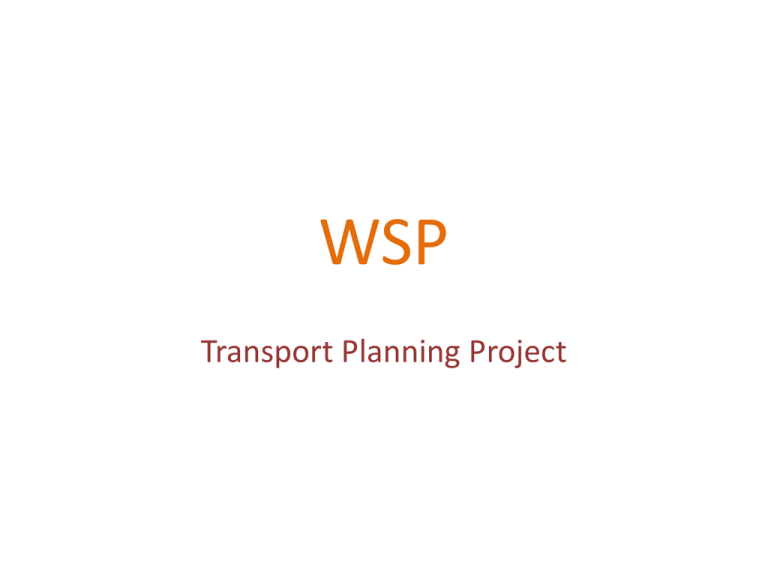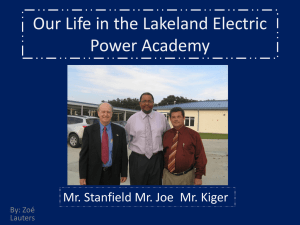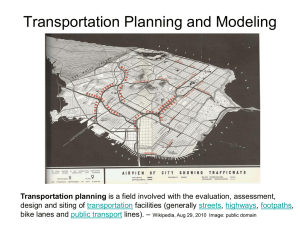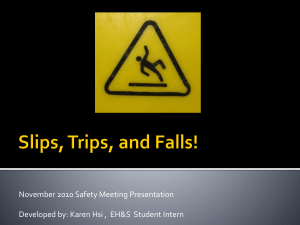WSP - challenge
advertisement

WSP Transport Planning Project The Project • Introduce you to elements of the transport planning process – – • A typical project or responsibility for WSP – • • When a developer wants to build a new housing development they need to provide: information on what impact the new houses and new residents will have on the local roads. For example: Do the additional cars added to the local roads once the houses are built, cause queuing at local junctions. WSP provide written assessments and use computer programs to analyse whether the new development will have a negative impact on the local roads and (if necessary) to what extent this impact can be avoided or mitigated by paying for improvements to junctions or other transport facilities. This project introduces factors that need to be taken into account when considering the traffic and transport impact that a new development will have. Any new development will generate person trips, which represent people travelling to and from the development for any purpose, be that work, school, shopping etc. The Project Brief • Consider the transport impact of a new residential development of 500 houses (Units) • Evaluate how the impact varies as you assign different proportions of all the trips generated by the development to different modes of transport (Car, Bus, Train, etc) Project Information • View the Network Diagram which shows the location of the new development (the triangle with DEV inside). • Other information shown on the diagram: • ROADS which link to the new development (shown by straight black lines) • LOCAL JUNCTIONS (shown by circles - J1, J2, J3) • BUS ROUTES along the roads (red dotted lines) • BUS STOPS(red dots) • Potential CYCLE LANE locations (green dashed lines). • RAILWAY LINE with two stations • BOAT/FERRY with two terminals • 4 EMPLOYMENT AREAS (A, B, C & D), which can be reached using the different modes of transport. Decision Making • To make decisions about how to distribute the trips go to: – “Inputs” Worksheet of the Excel File “WSP Travel & Transport Project” • The different transport modes shown on the diagram are: – Train , bus, boat, car driver, car passenger, cycling and walking • Different mode share distributions will have different impacts on the road network and consequently will incur different financial costs. Results • The “NETWORK OVERVIEW” tab shows the following results of the Inputs: – Number of cars at each of the junctions (shown by arrows), – Remaining capacity at the junctions, – Total number of trips to each employment zone by each transport mode. Improvement Costs • The “Reports” Tab, shows the following improvements that have been triggered for each mode and their costs • • • • Junction Improvements Bus Improvements Car Park Improvements Cycle Lane Improvements • There is no 100% correct solution • Correct solution will usually be dictated by the demands of clients or the Local Highway Authority (e.g. Hampshire County Council) • The solution which involves the lowest cost is likely to be most favoured by the client, but may not be most favoured by the Local Authority. Decision Choices • Aim to arrive at a combination of mode shares which results in the lowest overall costs incurred • Aim to keep the mode shares to realistic levels – example saying that very large proportions of people will get the bus and not many people will drive is unrealistic. • Assigning a mode share of less than 40% to car driver to any of the zones is probably unlikely in the current climate, with the possible exception of trips to employment A, which is located closest to the new development. INSTRUCTIONS • • Familiarised yourself with the 'Network Overview' and ‘Trip Gen’ tabs as detailed in the introduction. Section 1. Calculates the total number of trips that will be generated by the 500 houses. – • To work out the total number of trips you first need a trip rate, which in this case has already been worked out and is 0.900. In the peak hour (08:00 - 09:00) on average across the whole site there will be 0.9 trips per house. it is an average across the whole site, there are some houses which will not make any trips in the peak hour, e.g. elderly, unemployed or people who start work later. Instructions (Continued). • • • To obtain the total number of trips generated by the 500 homes the trip rate is multiplied 500, to give a total of 450 trips. These trips are then split down into the different transport modes, which here is based on average national percentage splits for all trips. For this project we are assuming that all peak hour trips are people travelling to work, we are ignoring trips to school, so we now need to assign trips to the different modes for each employment zone (A, B, C, & D). This is done under Point 2 on the 'Trip Gen' tab. To input changes to modes within A, B, C & D go to the “INPUTS” Worksheet Instructions (Continued). • • Once you have access the INPUTS WORKSHEET press Ctrl SHIFT M This will take you to the Management Screen Instructions (Continued). • By changing the mode shares in the boxes, you can adjust the amount of trips that are assigned to each mode for each of the four employment zones in turn • Each employment zone has already been given a percentage share of the total number of trips (i.e. 10%, 20% or 50%), based on the number of jobs available in that zone • You will need to go through each of the employment zones in turn and adjust the mode shares in order to redistribute the trips from the development onto the different transport modes • NOTE: Depending on the employment zone, only certain methods of transport will be available to get to that zone. • By changing the mode shares in certain ways you will incur costs Instructions (Continued) • The costs you will incur are summarised as follows: • BUS: If the total number of trips going by bus from the development is more than 70, you will trigger a cost for bus improvements. This represents the cost of putting an extra bus onto the route to accommodate the new trips • Further bus improvements will be triggered if more than 120 trips are assigned to bus • NOTE: The number 70 represents the threshold for a significant modal shift to bus, which is only likely to be achieved in reality if the bus service frequency is increased. Instructions (Continued). • CAR: Junction improvements will be triggered if more than 50 car trips are routed through junction 1, 100 car trips through junction 2, or 150 car trips through junction 3. • CYCLE: Cycle lane improvements will be triggered in order to make any increases to the mode share assigned to cycling. • CAR PARKING: Car parking improvements at the rail station and boat terminal will be required and triggered in order to assign trips to this mode of getting to the station/boat terminal. Instructions (Continued). • A summary of the costs that you will incur and the maximum number of trips that can be accommodated by each of the improvements is provided in Point 3. on the 'Trip Gen' tab • Care should be taken that the number of trips made possible by each intervention is not exceeded, i.e. no more than 50 cars can be accommodated by each car park improvement and no more than 100 extra vehicles can be accommodated by the junction 1 improvements. • As you make your mode share choices to each of the four employment zones you can see (under Point 4.) how they impact upon the average trip time per person (in minutes) to each zone. You can also see the average cost to each person of their trip to work. These two factors should be borne in mind when adjusting the mode shares to each zone. Results • • • Go to the ‘RESULTS' tab to see how your mode share decisions have affected the total costs incurred and which specific improvements you have triggered You can also see the remaining capacity of the junctions, together with a summary of the number of trips by each mode to each zone. The red and grey tabs are for information only and should not be edited. Editing should only occur in the yellow tab. MODE SPLIT Overall Mode Across 4 Employment Zones Total Mode Split Train 124 27.23% Bus 63 13.86% Car Driver 149 32.67% Car Pasr 43 9.41% Cycle 14 2.97% Walk 7 1.49% Boat 56 12.38% 455 100.00% RESULTS - IMPROVEMENTS Junction Improvements: J1 J2 J3 Yes No No Bus Improvements: -1 Bus Yes -2 Buses Yes Car Park Improvements: At Rail Station Yes At Boat Terminal Yes Cycle Lane Improvements: Required? Yes RESULTS - COSTS Costs Incurred Junction Improvements Bus Service Improvements Car Parking Improvements Cycle Lane Improvements Total Improvements Cost £350,000 £240,000 £500,000 £75,000 £1,165,000 OVERALL COST of CURRENT MODEL Overall Costs of Current Model Average per Person Trip Employment A Employment B Employment C Employment D Time (Hrs) Cost (£) 13.20 18.80 18.85 33.40 £1.00 £2.90 £4.23 £10.30







